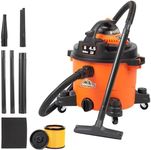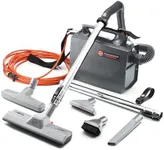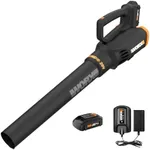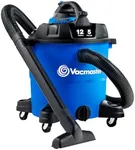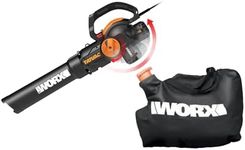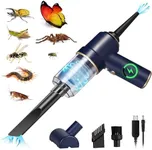Buying Guide for the Best Vacuum With Blowers
Choosing the right vacuum with a blower can make a significant difference in maintaining a clean and tidy home or workspace. These versatile machines not only help in vacuuming dust and debris but also in blowing away leaves, dirt, and other particles from hard-to-reach areas. To find the best fit for your needs, it's essential to understand the key specifications and how they impact the performance and usability of the vacuum with a blower. Here are the main specs to consider and how to navigate them.Power (Wattage)Power, measured in watts, indicates the strength of the vacuum's motor. A higher wattage generally means more powerful suction and blowing capabilities. For light cleaning tasks, a vacuum with lower wattage (around 600-800 watts) may suffice. For more demanding tasks, such as cleaning large areas or dealing with heavy debris, look for a vacuum with higher wattage (1000 watts or more). Consider your cleaning needs and the type of debris you typically encounter to choose the right power level.
Airflow (CFM)Airflow, measured in cubic feet per minute (CFM), determines how much air the vacuum can move. Higher CFM values mean better suction and blowing performance. For general household cleaning, a CFM of around 50-70 is usually adequate. For more intensive tasks, such as cleaning workshops or outdoor areas, a higher CFM (80 or more) is preferable. Assess the areas you will be cleaning and the type of debris to determine the appropriate airflow for your needs.
Tank CapacityTank capacity refers to the amount of debris the vacuum can hold before needing to be emptied. Smaller tanks (1-3 gallons) are suitable for light, occasional cleaning, while larger tanks (4-10 gallons or more) are better for extensive cleaning tasks and larger areas. If you frequently clean large spaces or deal with significant amounts of debris, a larger tank will reduce the frequency of emptying and improve efficiency.
Blower FunctionalityThe blower functionality allows the vacuum to blow air out, which is useful for tasks like clearing leaves, dusting hard-to-reach areas, or inflating items. Some vacuums have a dedicated blower port, while others require reconfiguration. Consider how often you will use the blower feature and choose a model that offers convenient and efficient blower capabilities. If blowing is a primary need, ensure the vacuum has a strong and easily accessible blower function.
Filtration SystemThe filtration system captures dust and allergens, preventing them from being released back into the air. HEPA filters are highly effective, capturing 99.97% of particles as small as 0.3 microns, making them ideal for allergy sufferers. Standard filters are sufficient for general cleaning but may not capture the finest particles. Choose a vacuum with a filtration system that matches your health needs and the level of air quality you desire.
Portability and WeightPortability and weight affect how easy it is to move the vacuum around. Lightweight models (under 10 pounds) are easier to carry and maneuver, making them suitable for quick and frequent cleaning. Heavier models (over 15 pounds) may offer more power and capacity but can be cumbersome to move. Consider your physical strength and the layout of the areas you will be cleaning to choose a vacuum that balances power and portability.
Attachments and AccessoriesAttachments and accessories enhance the versatility of the vacuum. Common attachments include crevice tools, brush nozzles, and extension wands. Some models come with specialized tools for pet hair, upholstery, or car interiors. Think about the specific cleaning tasks you will perform and choose a vacuum that includes the necessary attachments to make those tasks easier and more efficient.
